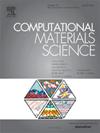利用选定的三维过渡金属掺杂剂对 ZnS (1100) 表面的光电特性进行工程化处理,以增强光电化学分水能力:DFT 研究
IF 3.3
3区 材料科学
Q2 MATERIALS SCIENCE, MULTIDISCIPLINARY
引用次数: 0
摘要
由于 ZnS(1100)表面在光激发时能迅速产生电子-空穴对,且氢气进化效率高,因此已成为一种很有前途的分水光催化剂。然而,由于其对紫外光谱的反应和电荷载流子的快速重组,其广泛应用受到了限制。研究表明,在 ZnS 中掺杂过渡金属可以改变其带隙边并改变其光学特性。尽管如此,系统地探索掺杂 ZnS(1100)表面在光电化学(PEC)应用中的潜力的综合研究还很少。本研究采用密度泛函理论方法,探讨了特定过渡金属(TM)掺杂剂(锰、铜、钴和铁)对 ZnS(1100)表面光电特性的影响。结果表明,钛金属掺杂剂在 ZnS(1100)表面的稳定性取决于钛金属掺杂剂的 d 特性及其浓度和掺杂位点。此外,与富含 S 的条件相比,富含 Zn 的合成条件更有利于引入 TM 掺杂剂。值得注意的是,在所研究的掺杂剂中,铜的稳定性最高,而钴、锰和铁的稳定性则依次降低。锰和铁(掺杂浓度在 1-6% 之间)导致带隙能分别降低了 15-60% 和 19-51%,而类似浓度的铜和钴掺杂则导致带隙能更大幅度地降低,分别降低了 37-78% 和 26-75%。此外,带边排列分析表明,掺杂了 4% Cu 和 2% Co 的 ZnS(1100)表面低于水的氧化还原电位(H+/H2)。因此,预计铜和钴会诱发显著的蓝移,并提高 PEC 活性。本文章由计算机程序翻译,如有差异,请以英文原文为准。

Engineering the optoelectronic properties of ZnS (1100) surface using selected 3d transition metal dopants for enhanced Photoelectrochemical water Splitting: A DFT study
ZnS (1100) surface has emerged as a promising photocatalyst for water split- ting due to its rapid generation of electron-hole pairs upon photoexcitation and high hydrogen evolution efficiency. However, its widespread use has been limited by its response to UV spectrum and rapid recombination of charge carriers. Studies have shown that doping ZnS with transition metals can modify its band gap edge and alter its optical properties. Despite this, there are few comprehensive studies that have systematically explore the potential of doped ZnS (1100) surface for Photo-electrochemical (PEC) applications. In this work, the effects of selected transition metal (TM) dopants (Mn, Cu, Co and Fe) on the optoelectronic properties of ZnS (1100) surface using density functional theory approach has been explored. The results showed that the stability of TM dopants in ZnS (1100) surface is dependent on the d character of the TM dopant as well as their concentration and doping site. Further, it was noted that Zn-rich synthesis conditions were favorable for introduction of TM dopants compared to S-rich conditions. Notably, among the dopants studied, Cu exhibited the highest stability, whereas Co, Mn and Fe displayed decreasing levels of stability. Mn and Fe (for dopant concentration between 1–6%) induces reduction of band-gap energy by 15–60% and 19–51%, respectively, while Cu and Co dopants of similar concentrations induced a more dramatic reduction of band gap energy between 37–78% and 26–75%, respectively. Additionally, band-edge alignment analysis showed that ZnS (1100) surface doped with 4% Cu and 2% Co falls below the redox potential of water (H+/H2). Therefore, Cu and Co are anticipated to induce significant blue shift and offer improved PEC activity.
求助全文
通过发布文献求助,成功后即可免费获取论文全文。
去求助
来源期刊

Computational Materials Science
工程技术-材料科学:综合
CiteScore
6.50
自引率
6.10%
发文量
665
审稿时长
26 days
期刊介绍:
The goal of Computational Materials Science is to report on results that provide new or unique insights into, or significantly expand our understanding of, the properties of materials or phenomena associated with their design, synthesis, processing, characterization, and utilization. To be relevant to the journal, the results should be applied or applicable to specific material systems that are discussed within the submission.
 求助内容:
求助内容: 应助结果提醒方式:
应助结果提醒方式:


